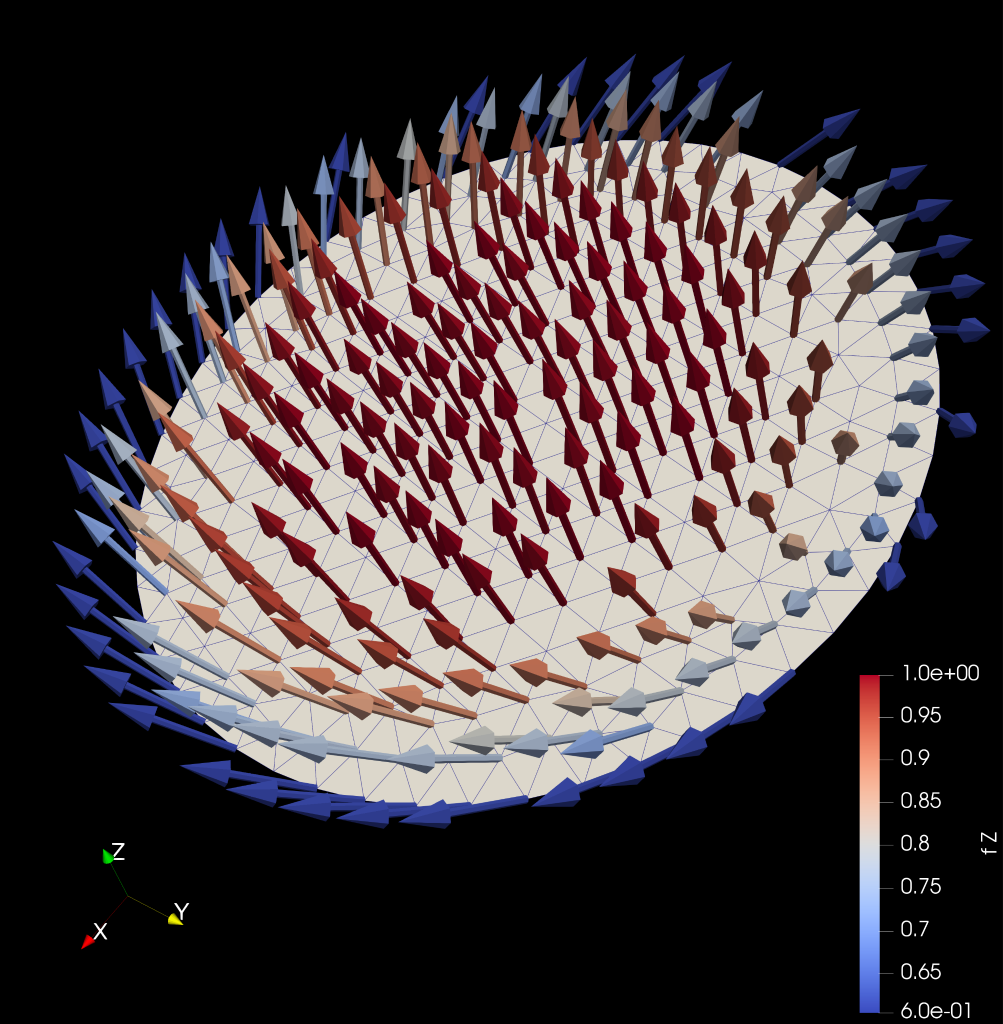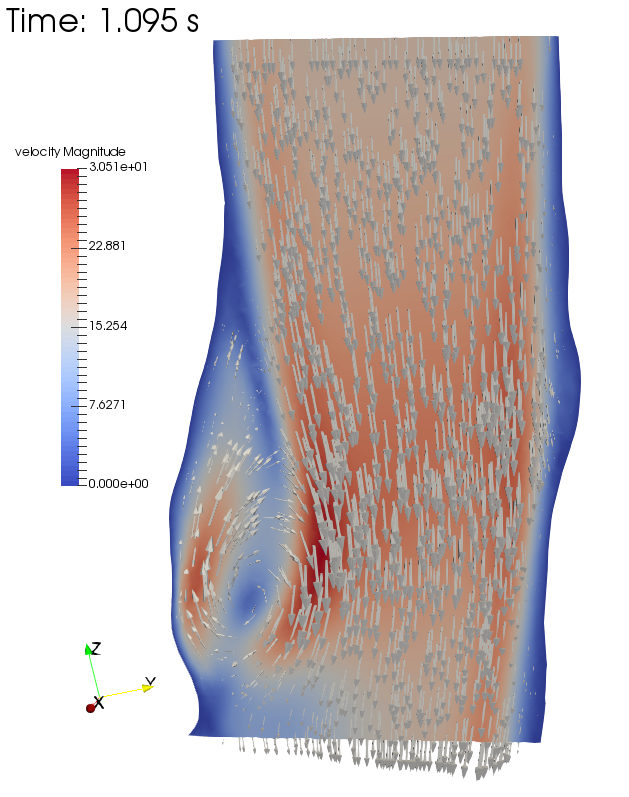Projects
Sparse grid approximation of stochastic PDEs: Adaptivity and approximation of the stochastic Landau–Lifshitz–Gilbert equation
My Doctoral thesis, written at TU Wien under the supervision of Prof. M. Feischl
You can access it on the TU Wien publications archive
This dissertation tackles the approximation of partial differential equations (PDEs) with random data, focusing on random coefficient PDEs and stochastic PDEs (SPDEs).
As a first result, we present and analyse an adaptive sparse grid-finite element approximation of the random diffusion Poisson equation. The algorithm is based on the reliable a-posteriori error estimator [Guignard, Nobile; SIAM J. Numer. Anal. (2018)]. Firstly, we examine a parametric semidiscrete setting. We consider two possible parametric enrichment strategies and prove plain convergence and convergence with rate (with respect to the number of refinement steps) for both. Secondly, we present the fully discrete algorithm, which additionally incorporates finite element adaptivity. We consider the use of the same or different meshes for distinct collocation nodes in parameter space. We prove rate-optimality of the finite element refinement with tools from [Carstensen, Feischl, Page, Praetorius; Comput. Math. Appl. (2014)]. Finally, combining the convergence results leads to the plain convergence of the fully discrete algorithm.
As a second result, we present a novel numerical scheme for nonlinear SPDEs driven by Gaussian noise. A surrogate of the random field solution is efficiently computed following these steps:
- Reduce the problem to approximating a parametric coefficient PDE through the Doss-Sussmann transform and the Lévy-Ciesielski expansion of the Wiener process;
- Prove four regularity properties, which ensure holomorphic regularity and sparsity of the resulting parameter-to-solution map;
- Use the sparsity information to design an a-priori sparse grid interpolation scheme, which can overcome the curse of dimensionality.
We apply this method to the stochastic Landau–Lifshitz–Gilbert (SLLG) equation, a model for micrometer-scale magnetic bodies whose magnetization is perturbed by heat fluctuations. This SPDE is mathematically and computationally challenging due to its nonlinearity and the presence of Gaussian noise. For SLLG, we prove the four regularity properties in two functional settings: Either Hölder or Lebesgue integrable sample paths in time. The second setting leads to algebraic, dimensions independent convergence of the sparse grid interpolation. Finally, we apply the multilevel sparse grid-finite element scheme [Teckentrup, Jantsch, Webster, Gunzburger; SIAM/ASA J. Uncertain. Quantif. (2015)] and demonstrate its superiority over the single-level method.
The results are validated through numerical experiments, some of which are performed using SGMethods, a Python implementation of sparse grid interpolation developed in conjunction with this dissertation.
SGMethods: Python implementation of sparse grid interpolation.
Approximate high dimensional functions based on point samples.
Check the repository of the project.
Sparse grid Interpolation (also called stochastic collocation) is an approximation method for high-dimensional functions, i.e. functions that depend on many scalar input variables.
The algorithm uses point samples (the “sparse grid”) to generate a polynomial interpolant of the original function that can be evaluated cheaply and quickly.
SGMathods can be used to interpolate any function, but the focus is on parametric coefficient PDEs, with useful functions and a number of examples already implemented. This is the kind of problem you need to solve when approximating random coefficient PDEs.
Here are some of the key features:
- Python object-oriented implementation, with tests and documentation;
- Wide range of implemented interpolation nodes and interpolation methods to choose from;
- User-defined 1D interpolation operators (e.g. piecewise linear functions or global Chebyshev polynoamials) can esaily defined and are automatically “upgraded” to a sparse grid method;
- Algorithms designed to scale well with the number of scalar input variables, even for very high dimensions;
- Adaptive sparse grid selection based on profit maximisation (coming soon);
- A multilevel sparse grid interpolation class implementing the method from [Teckentrup et al., SJUQ, 2015]). It dramatically reduces the cost of approximating random coefficient PDEs by cleverly combining sparse grid and finite element resolutions.


Sparse grid approximation of nonlinear stochastic PDEs.
With an application to the stochastic LLG equation (micromagnetics).
Research paper written at TU Wien and UNSW, accepted for publication, with Prof. M. Feischl, Dr. X. An, Prof. J. Dick, Prof. T. Tran.
Download the Preprint (PDF).
We show convergence rates for a sparse grid approximation of the distribution of solutions of the stochastic Landau-Lifshitz-Gilbert equation.
Beyond being a frequently studied equation in engineering and physics, the stochastic Landau-Lifshitz-Gilbert equation poses many interesting challenges that do not appear simultaneously in previous works on uncertainty quantification: The equation is strongly non-linear, time-dependent, and has a non-convex side constraint. Moreover, the parametrization of the stochastic noise features countably many unbounded parameters and low regularity compared to other elliptic and parabolic problems studied in uncertainty quantification.
We use a novel technique to establish uniform holomorphic regularity of the parameter-to-solution map based on a Gronwall-type estimate and the implicit function theorem. This method is very general and based on a set of abstract assumptions. Thus, it can be applied beyond the Landau-Lifshitz-Gilbert equation as well.
We demonstrate numerically the feasibility of approximating with sparse grid and show a clear advantage of a multi-level sparse grid schemes

Convergence of adaptive sparse grid-finite elements for affine diffusion Poisson.
Research paper written at TU Wien, published on CAMWA in 2021, with Prof. M. Feischl.
Link to Journal Article.
Download the Preprint (PDF).
We consider a Poisson partial differential equation with random diffusion coefficient. This model has applications e.g. in ground water flow modelling, in which the composition of the soil is not precisely know.
We discretize it with a combination of finite elements (to approximate the spatial dependence) and a sparse grid stochastic collocation (to approximate the random component). Both methods are adaptive, in the sense that the algorithm computes a sequence of solutions and automatically chooses how to refine them to improve accuracy optimally.
We give a thorough theoretical description of the method and its theoretical properties. We prove for the first time the convergence of such a stochastic collocation-finite elements algorithm.

Trimmed isogeometric discretization of the Stokes problem.
Master Project carried out at EPFL, 2019, with Dr. R. Vasquez, Dr. P. Antolin, and Prof. A. Buffa.
Download the Report (PDF).
IsoGeometric Analysis (IGA) is a Galerkin-type numerical method for approximating solutions of PDE. While finite elements are based on piecewise polynomials, IGA uses splines as its building block, both to discretize the computational domain, as in CAD software, and as basis functions to represent the approximate solution.
Trimming is an important CAD operation that allows one to manipulate geometric primitives by taking their union, different, or making a cut along a curve.
In this project, we investigate the effect of trimming on the approximation of the Stokes problem with Taylor-Hood (TH) and Raviart-Thomas (RT) isogeometric elements. Both methods can converge faster than finite elements, and isogeometric RT generates an exactly zero-divergence numerical solution. We first extend the Matlab package GeoPDEs with the necessary functionalities to treat trimmed. Then, we perform several numerical experiments with different trimming configurations and TH or RT methods.

Global optimization algorithms for semiconductor devices.
Project carried out at Fluxim AG, Winterthur, 2018, with Dr. S. Altazin and the Fluxim team.
During my internship at Fluxim AG, I researched and implemented global optimization algorithms to expand the capabilities of the simulation software Setfos.
I used Python to research and test global optimization algorithms, such as simulated annealing, genetic algorithms, simplex optimization, and bayesian global optimization.
Algorithms were tested against problems from semiconductor engineering, for example, the optimization of a tandem solar cell.
Finally, I implemented a selection of the researched algorithms in a C++ library, which was then integrated into the company software Setfos. The library, which I called GLobOpt, features extensive documentation and unit tests.

Optimization of the rate of convergence of diffusions.
Project carried out at EPFL, Lausanne, 2018, with Dr. S. Krumsheid and Prof. F. Nobile.
Download the report (PDF)
We study the method described in [Lelièvre et al. J. Stat. Phys, 2013] to accelerate the convergence of Stochastic Diffusion Processes through a perturbation of their drift term that does not alter the stationary distribution. This method is based on the connection between diffusion processes and the spectral gap of the Fokker-Planck operator, i.e. its first nonzero eigenvalue.
We study the problem of approximating eigenvalues of differential operators. We also solve the problem of finding the best perturbation, i.e. the one that leads to the maximal acceleration of convergence, with global optimization methods.
Eigenvalue problems are solved with the finite elements programming language FreeFem++ and global optimization problems are solved in Matlab.
This method could have important applications e.g. in Markov-Chain Monte Carlo (MCMC) sampling, in which a desired probability measure is sampled by treating it as the stationary distribution of a Markov Chain.

Simulation of the blood flow in abdominal aortic aneurysms
Project carried out at EPFL, Lausanne, 2017, with Dr. C. Colciago and Prof. A. Quarteroni.
Download the report (PDF)
Abdominal aortic aneurysms (AAA) is a pathology that cause 1 to 3% of the deaths among men aged between 65 and 85 in developed countries. One possible therapy is Endovascular Aneurysm Sealing (EVAS), which consists of filling the AAA sac with a polymer and making the blood flow through a stent.
We simulate the blood flow in a section of the abdominal aorta with Finite Elements and BDF time stepping. We study pre- and post-operatorial settings and compute quantities of interest that allow for a quantitative comparison (e.g. the Wall Shear Stress, the oscillatory shear index, etc.).
Computation meshes are generated with Gmsh, finite element simulations (instationary Navier-Stokes) are carried out with the C++ library LifeV, and results are visualized in ParaView

